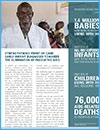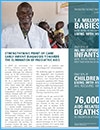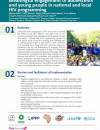You can sort the documents in the resource library using the filters below. Filters can be used singly or in combination. You can reset the filters at anytime using the "Reset" button. The search function at the top of the page is also available. If you would like to submit a publication to the resource center, please send it to childrenandaids@unicef.org
| Document | Download | Description | Year | |
|---|---|---|---|---|

|
POC EID Implementation Approaches - English , POC EID Implementation Approaches - French | Expanding access to POC early infant diagnosis: Implementation approaches and testing strategies |
2018 | |

|
Strengthening Point-of-Care Early Infant Diagnosis ENGLISH | A game changer for paediatric HIV, point-of-care early infant diagnosis (POC EID) is an innovative approach to strengthen EID programs, and improve health outcomes for the youngest and most vulnerable children. |
2018 | |

|
Strengthening Point-of-Care Early Infant Diagnosis FRENCH | Susceptible de changer la donne en matière de traitement pédiatrique du VIH, le dépistage précoce du nourrisson (DPN) sur le lieu de soins est une approche innovante visant à renforcer les programmes de DPN et il amé |
||

|
Care of the HIV-Exposed Infant Flipchart.pdf | CDC-Atlanta Maternal Child HIV Branch and International Lab Branch, in collaboration with partners, have developed tools to support health care workers and laboratorians to provide services to HIV-exposed infants, includin |
2018 | |

|
Post-market surveillance aims to ensure that IVDs continue to meet the same quality, safety and performance requirements as when they were initially pl |
2018 | ||

|
Summary of Research Articles - Q3 2018 | 2018 | ||

|
HIV-Sensitive Social Protection in Eastern and Southern Africa initiative - final evaluation | This document evaluates the Expansion and Scale-Up of HIV-Sensitive Social Protection in Eastern and Southern Africa initiative, implemented by UNICEF in Malawi, Mozambique, Zambia and Zimbabwe from 2014-2018 with support |
2018 | |

|
CHAI Site Selection Tool Guidance | The CHAI Site Selection Tool is a decision-making resource designed to assist national stakeholders in selecting the most appropriate point-of-care (POC) products and sites for early infant diagnosis (EID) and HIV viral lo |
2018 | |

|
Site Monitoring Guidance , Hub Testing Site - POC-EID.pdf , Spoke Site - POC-EID.pdf , Stand Alone Testing Site - POC-EID.pdf | Regular monitoring of POC EID implementation sites is crucial for ensuring the quality and efficacy of site-level operations throughout the pr |
2018 | |
| |
Receiving and Storing Dried Blood Spots - DBS - Laboratory Job Aid.pdf | CDC-Atlanta Maternal Child HIV Branch and International Lab Branch, in collaboration with partners, have developed tools to support health care workers and laboratorians to provide services to HIV-exposed infants, includin |
2018 | |
| |
Collection of Dried Blood Spots - DBS - Clinic Job Aid.pdf | CDC-Atlanta Maternal Child HIV Branch and International Lab Branch, in collaboration with partners, have developed tools to support health care workers and laboratorians to provide services to HIV-exposed infants, includin |
2018 | |

|
Guidance on Competency Assessments for POC EID Testing , Abbott-mPIMA Form , Cepheid-Xpert HIV 1 Quality Form | Regular assessments of the competency of POC EID device operators are crucial for ensuring the quality of the testing procedure at an individual level, and can also serve as a key component of a POC EID quality assurance ( |
2018 | |

|
Addressing the service delivery needs of children of key populations | Motherhood is common among female sex workers (FSWs) and many have at least one biological child. |
2018 | |

|
Point-of-care testing as a solution for timely early infant diagnosis | Despite remarkable progress in prevention of mother-to-child transmission of HIV (PMTCT), 160,000 children were newly infected with HIV in 2016. |
2018 | |

|
A child-centred approach for HIV programs | As part of their basic human rights, children need access to the best health care possible, safe water to drink, nutritious food, and a clean and safe environment to grow and develop to their full potential. |
2018 | |

|
Providing peer support for adolescents and young people living with HIV | WHO recommends peer support, including peer counseling, for adolescents and young people living with HIV age 10-24 years (AYPLHIV). |
2018 | |

|
Family-based index case testing to identify children with HIV | Paediatric HIV treatment coverage is stagnating. The most recent estimates suggest that only 46% of children living with HIV are on treatment, well below the AIDS Free target of 1.6 million by the end of 2018. |
2018 | |

|
Providing differentiated service delivery to children and adolescents | Children and adolescents living with HIV (CALHIV) have a lifetime of antiretroviral therapy (ART) ahead of them. |
2018 | |

|
Sensitizing health workers to providing responsive care for adolescents and young people living with HIV | The 95-95-95 targets will only be achieved with zero discrimination, including within healthcare settings. |
2018 | |

|
Meaningful engagement of adolescents and young people in national and local HIV programming | Adolescents and young people (AYP) (10-24 years) are being left behind in the HIV response, with high levels of new infections, and lower levels of diagnosis and treatment coverage than adults. |
2018 |